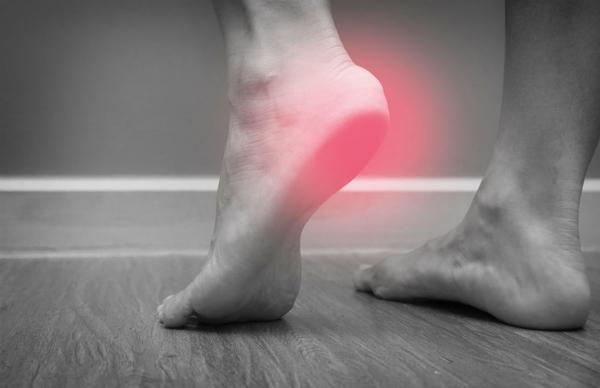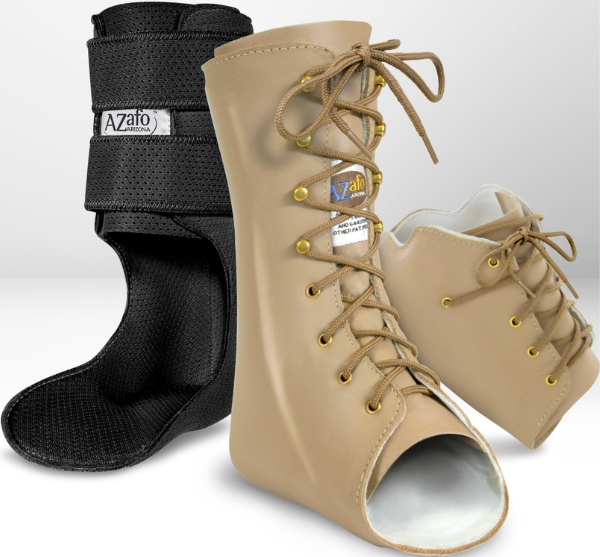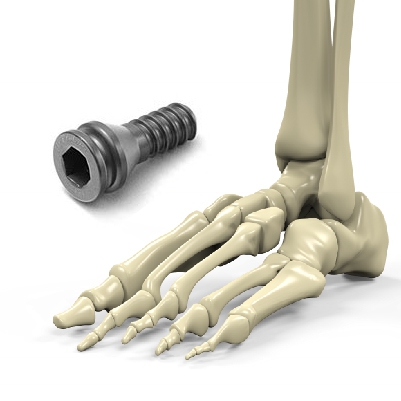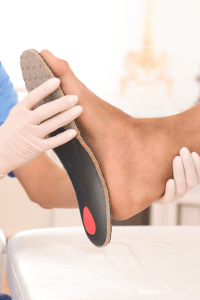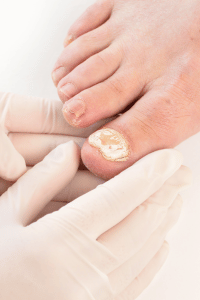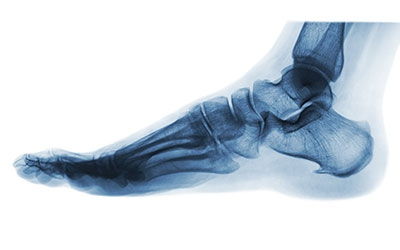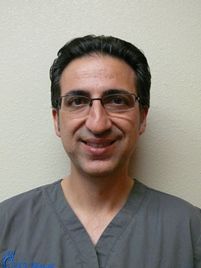X-rays:
X-rays show us what your bones and joints look like inside your feet and ankles. This is best accomplished when you put your full weight on your feet. As a result, we can better evaluate the position of your bones and joints while you are standing.
The positions of the bones and joints in your feet change dramatically when you put weight on your feet. Without weight on your feet, the bones and joints are relaxed and contract. When you put your weight on your feet, the bones and joints move and stretch out to a different position. It is essential to capture an accurate picture of your feet and ankles in making a proper diagnosis.
X-rays only take a few minutes to perform and give us a load of information on how your feet are working. We can easily see bones and joints that are out of alignment or broken.
Diagnostic Ultrasound:
A diagnostic ultrasound examination or sonogram shows us what your tendons, ligaments, plantar fascia, soft tissues, joints and bones look like inside. This examination is extremely helpful in diagnosing soft tissue injuries and diseases. It can also show cysts, tumors, pinched nerves, hematomas and infections.
We can also use this device to guide us in removing fluid or injecting a medication into a very specific area inside your foot or ankle.
A diagnostic ultrasound examination is easy to perform and most often painless. It usually takes about 5 to 10 minutes to perform. It can give us the answers we are looking for to make the right diagnosis quickly. In many situations, a diagnostic ultrasound examination avoids the need for an MRI (Magnetic Resonance Imaging), which can be very costly.
Circulation Testing:
Circulation testing shows us how your arteries are doing in your legs. This test is not invasive. In other words, no needles! It uses a series of blood pressure cuffs to measure the blood flow in different parts of your legs. There is no pain with this test and it only takes about 45 minutes to perform.
It shows us the Pulse Volume Recording (more or less the waveform of your pulse) and the Ankle Brachial Index (the ratio of your ankle blood pressure to your arm blood pressure.)
With this information, we can see if there is a restriction in your blood flow to your foot.
This test is extremely helpful in all diabetic patients since they have a higher tendency to develop clogged arteries in their legs. We call this Peripheral Arterial Disease or PAD. Early detection of this condition is the key to preventing amputations.
The test is performed here in the office by a trained staff member and the results are reviewed by an independent doctor that is specialized in this field of medicine.
We work very closely with Vascular Surgeons who can take care of this condition once it has been diagnosed.
Nerve Testing:
Nerve Conduction Velocities or NCV is a test that shows how well your nerves are conducting electricity. It is very useful in diagnosing degenerative nerve diseases we call peripheral neuropathy. It may also be useful in diagnosing pinched nerves in the leg or foot.
This test is very tolerable and takes about an hour to perform. These tests can be performed here in the office by a trained technician. The results are reviewed by an independent doctor that is specialized in this field of medicine.
In some situations, you may need an Electromyogram or EMG which shows how the nerves going to your muscles are working. This test is usually helpful in advanced cases of nerve degeneration. This test is only performed by a trained doctor.
Extracorporeal Pulse Activation Treatment:
We are proud to offer this very advanced and effective non-invasive treatment approved by the FDA. The device makes special pressure waves that increase the local blood flow and metabolism, and speed up healing. Your pain is thereby reduced and eliminated.
This treatment is extremely helpful in new or old injuries, tendonitis and heel pain. It is performed here in the office and usually takes about 10 minutes to perform. You will usually need 3-4 treatments for each condition. You don’t need any anesthesia or injections. You can even walk on your foot right after the treatment.
In many patients, this treatment can eliminate the need for surgery.
Therapeutic Laser:
A medical laser is used to relieve pain in sore muscles, tendons, joints, and nerves. It does this by releasing energy into the skin and deeper tissues. The heat created by this process relieves the pain.
You will need 2-3 treatments per week for several weeks and then a booster treatment every month to be effective. The treatments are very comfortable and do not require any anesthesia. Each treatment usually takes about 15 minutes to perform.
This treatment is very useful in patients that are not good candidates for surgery. It may also be used in conjunction with other medical treatments to achieve the results you want.
Surgical Laser:
We use a diode laser to kill unwanted organisms that grow in our skin or nails. This laser is most useful in getting rid of toenail fungus and warts. Laser light goes through the nail and vaporizes the fungus cells without causing any damage to the nail or skin.
Most people have minimal to no pain when we perform this procedure. Some people feel a little heat or pinprick. Local anesthesia is not required.
Toenail fungus usually requires 3-4 treatments and warts usually require 2-3 treatments. You may need booster treatments down the road if the condition returns.
You must be properly evaluated by one of our doctors before having this procedure performed.
Cosmetic Nail Restoration:
Keryflex is a treatment that makes your ugly thick toenails look like normal nails in one visit. We will trim your old nail and apply the product to the remaining nail and skin. This painless procedure usually takes about 15 minutes to perform. When the treatment is done, you are free to file it and apply your favorite nail polish.
This product also has some anti fungal properties that minimize the spread of fungus to your other toenails. This treatment can be combined with laser nail treatments and topical anti fungals to achieve optimum results. The treatment needs to be performed regularly as your new nail grows out and pushes the product out. This product will hide your ugly toenail while a new healthier nail grows out.
Diabetic Shoes & Insoles:
Diabetic shoes are special shoes that have a wider and deeper toe box (where your toes sit). They are used in diabetic patients to protect their feet from rubbing against the shoe and prevent a sore or blister from forming. These shoes are essential in the daily care of diabetic feet.
Diabetic insoles are made with specific materials to help reduce pressure in certain parts of your feet that are prominent. They work with diabetic shoes to prevent sores (ulcers), infection and amputation. They may be prefabricated or custom made depending on your foot structure.
You must be evaluated by our doctors to see if you need diabetic shoes and insoles. We will measure your feet and prescribe the most appropriate diabetic shoes and insoles. Diabetic shoes and insoles may be covered by your health insurance policy.
Custom Orthotics:
Custom foot orthotics are medical devices that help distribute your weight evenly in your feet. They are made from molds of your feet and sent to a lab with a prescription to be made. It usually takes about 3 weeks to make a pair of custom foot orthotics.
Custom foot orthotics are very important in treating conditions such as foot deformities, heel pain and tendonitis. They also reduce the likelihood of further injury and pain.
These devices have been widely used in children and adults for many decades. We are happy to offer the latest technology in custom foot orthotics.
It may take a few weeks for you to get adjusted to a new pair of foot orthotics. You have to gradually break them in with a good pair of shoes. You may experience some soreness in your feet, legs or lower back. This is normal process.
The rest of your body is also affected when you wear these devices. After you have gotten used to wearing your orthotics, you may notice less pain in your knees, hips, back or neck.
Custom foot orthotics do not last forever. The average lifespan of a custom foot orthotic is 2 years in adults and 1 year in children. That is because your feet will change their structure over time as you wear them. The most common change is your arch height and length.
It is essential that the arch of the orthotic matches the arch on your feet. You must be properly evaluated by a podiatrist to make sure orthotics are right for you.
Custom Shoes:
Custom shoes are shoes that are made with a prescription that is specific to your foot condition. They help protect and improve the function of your feet. They are especially useful in patients who have deformities that cannot be fixed with surgery. They are also commonly used in diabetic patients.
Molds of your feet are made and sent to a custom shoemaker that builds the shoes with special materials. These shoes typically include a custom made insole.
Custom Braces:
Custom braces or ankle-foot orthoses (AFO) are prescription medical devices that help you walk better. They help improve your balance and gait. You are less likely to fall if you use one of these devices.
They are made from molds of your foot and lower leg. They are made in a lab by a professional. They are very helpful for people that have a history of weakness in their legs, drop foot and severe foot and ankle deformities.
Orthotic Sandals:
Sandals and flip-flops can be beneficial if they have a good built-in high arch support. These are great for patients who don’t want to wear their shoes and orthotics all the time. They come in several different styles and colors. Men, women and kids can benefit from them.
Support Hose and Socks:
Support hose and socks are primarily used to control swelling in your feet and lower legs. They give you even compression from your toes to your knee or thigh to promote better circulation of blood. They come in different pressure gradients (tightness), styles and colors. Most patients would benefit from simple knee-high compression socks for everyday use. Ask our doctors if you could benefit from them.

